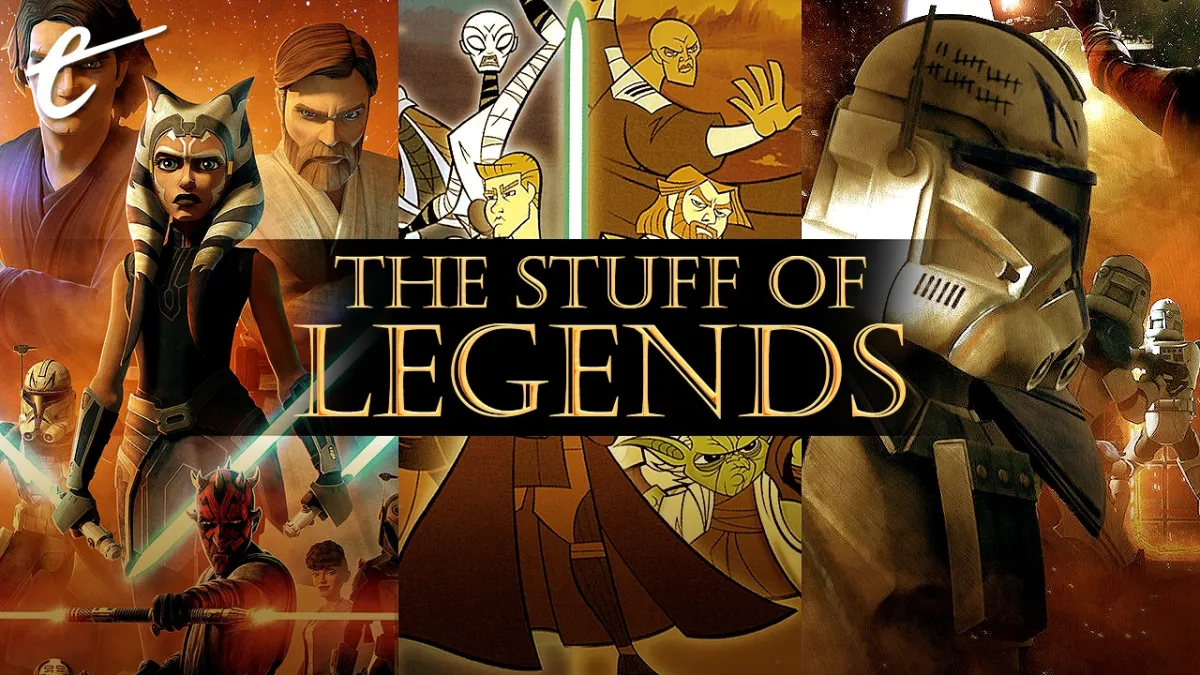Until Star Wars: The Force Awakens arrived, the Clone Wars was perhaps the most divisive era of Star Wars lore. However, besides the prequel trilogy movies themselves, it didn’t actually feel that way from the outside looking in.
Truth be told, it was during this time, in the late ‘90s and early 2000s, when the Star Wars Expanded Universe really came into its own. There were even dialog and narrative threads in the Expanded Universe that connected to then-in-production film projects, especially Revenge of the Sith.
Nowhere is this more obvious than Genndy Tartakovsky’s Star Wars: Clone Wars microseries. Across three seasons of interconnected shorts, Tartakovsky’s team at Cartoon Network took effectively everything people loved and hated about the prequel films – and made it work. There’s the epic scale of huge armies clashing, the Jedi at their peak power. They even take whiny Attack of the Clones Anakin and turn his ego into an effective character trait, for good and ill for those around him.
The series is all the more unique for serving as a cohesive bookend for what was known at the time as the Clone Wars multimedia project. It’d be like Shadows of the Empire, but on a more massive scale across games, books, comics, and the show. Fans could watch the conflict play out in real time over several years.
It all thoroughly interweaves, yet stories also function as standalone, parallel works of fiction. Don’t know who Durge is? You’re good! Never met an ARC trooper before? Not a problem! From adult tales like Shatterpoint and Republic Commando or teen-inclined content such as Star Wars: Republic, to all-ages fare such as Tartakovsky’s series, you could approach the Clone Wars with the ease of approaching the Bobbinsverse.

In many ways, this era is Star Wars at its full storytelling potential. It’s also Star Wars at its most Arthurian, embracing fantasy and surrealism for a heightened experience – a world you can believe in that’s still unabashedly free to be as campy and over the top as needed.
The Clone Wars era was destined to end in tragedy, but perhaps in more ways than initially realized. A new Clone Wars project was unexpectedly announced. This was Dave Filoni and George Lucas’ Star Wars: The Clone Wars, a revitalization that began in 2008, consisting of a new CGI movie and TV show that would unify all the storytelling with cutting-edge tech and a singular vision.
While the idea of giving Anakin a Padawan learner wasn’t all that warmly received at first, most fans were optimistic. The trailers for the animated movie looked reasonably good, especially for what was essentially a made-for-TV movie being released to cinemas. For younger fans coming of age, this would be their entry point to the franchise.
And when it launched, it was a hot mess on every front. Nowadays, everyone reflects on the seasons of Star Wars: The Clone Wars where it finally found its bearings — by most estimations between seasons three and four. By that point, the majority of the damage was done — damage that, in some cases, is still being addressed over a decade later, even by some of the minds behind The Clone Wars.
It’s not that The Clone Wars lacks its own good stories or interesting ideas. The Umbara, Onderon, slavers of the Republic, and Obi-Wan “Deception” arcs are all exceptionally told stories. Certain episodes like “Bounty,” “Heroes on Both Sides,” “Voyage of Temptation,” “Rookies,” and “Holocron Heist” are well worth watching. As a purely isolated product, it can be derivative at times, forcing one too many homages to the original trilogy into certain stories, but overall it’s fine with some good bits.

However, much of The Clone Wars’ early years were characterized less by amazing storytelling and more by being a bull in a china shop to the rest of the Expanded Universe. The Mandalorians went from Chaotic Neutral Maori-inspired warriors who could tip the scales of any conflict to… pacifist Swedes and Englishmen. Their homeworld went from a jungle biome with few cities and a more eco-friendly lifestyle to a barren wasteland.
It got so bad that Karen Traviss, at the time writing for The Clone Wars’ tie-in novels as well as the Imperial Commando sequel series, left the franchise entirely as whole swaths of her work were erased by the show. Though the retconning of Mandalore was by far the most dramatic case, it wasn’t the last.
Count Dooku’s apprentice Asajj Ventress was not only redesigned, but retconned into being a Nightsister rather than a self-made Dark Jedi. Her new origins also led to a massively reductive rewrite of the Nightsisters as distinctly evil, rather than a morally flexible order of liberated women. Meanwhile, Aurra Sing went from being a compelling fallen Jedi apprentice-turned-bounty hunter to essentially being Jango Fett’s ex-girlfriend who constantly slips up. And Barriss Offee’s age, rank in the Jedi Order, role in the war, and personality were all changed, much to the detriment of her final story arc.
The most frustrating contrast is how General Grievous degenerates into perhaps the most incompetent villain of the era. In the microseries, a justification is given for why he’s weaker and coughing — Mace Windu pulled a Darth Vader and nearly crushed the villain’s chest plate. Up until that point, Grievous had been utterly terrifying, shown as an indomitable force. Rather than explore this further, Cad Bane would inexplicably become the Separatists’ most effective henchman.
However, despite how The Clone Wars trampled through the canon amid its growing pains, it attracted tremendously more attention as a TV show than a video game or book would. Most people who tuned in weren’t aware of any larger continuity wrinkles, but those who knew better were left frustrated. The canon was becoming a mess.
To the credit of those working on the show’s ancillary novels, comics, and games, they made greater efforts to unite the show with the existing canon. These stories featured some great deep cuts and worked more cohesively with the rest of the setting. There was even a novelization of the series’s original movie that expanded on and polished the script substantially — ironically written by Traviss.
Ultimately, it’s oddly fitting that Star Wars: The Clone Wars outlasted the original Expanded Universe. It was much less a part of that timeline and far more a soft reboot before the hard reset finally rolled in. Again, on its own, The Clone Wars isn’t a terrible TV series. I’d personally argue it’s more average than outstanding, but in the age of “content” like The Book of Boba Fett, that still counts for something. I was just at the age for both takes on the Clone Wars to appeal to me, and with the benefit of hindsight, both show their age in differing ways.
The original Clone Wars multimedia project not only connected to the larger storyline, but stood on its own as a bold multifaceted project. It also presented a bleaker, more stoic view of the conflict — one where the clones more closely resemble the image the Empire would later bring. By comparison, The Clone Wars is a far more focused vision with a generally more jovial tone until its final seasons. It also takes an abnormally long number of seasons to find its footing. Each vision of the era is enjoyable, but as always with Star Wars, there’s also a legacy of creative differences that holds just as much drama as the space battles.





